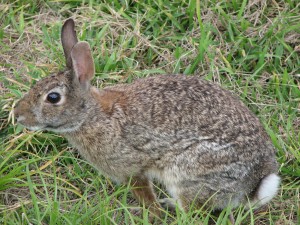Cottontail Rabbit
Cottontail rabbit (Sylvilagus floridanus) photo by Harvey Henkelmann
The cottontail has a stubby tail with a white underside. They have flat molars for grinding food. Their eyes are located on the sides of the skull for a wider field of view to locate predators. At birth, they are blind and deaf. But after a week, they can see and hear; and, after roughly two weeks they leave the nest. Although mainly nocturnal, rabbits are active in the early morning and at dusk. During the day, cottontails often remain hidden in vegetation.Predators include coyotes, foxes, weasels, eagles, owls and hawks. Cottontails are herbivores that eat grasses, clovers, sedges, legumes, fruits asters, fleabanes, sedges, horse nettle, cinquefoil, strawberry, clovers, & alfalfa, sumacs, foxtail, tall thistle, timothy, dandelion and even poison ivy. In agricultural areas, they’ll eat corn and soybeans.In the winter they’ll eat the bark and buds of shrubs and trees. The best rabbit habitat includes dense vegetation for escape cover like sumac and blackberry & plum thickets. Unfortunately, agricultural land today doesn’t often retain this kind of vegetation required for optimal habitat. Vast areas planted with single crops and modern tastes for mowed grass landscapes have reduced cottontail populations. Rabbits make a great pet for teaching responsibility to kids. The Quail and Upland Wildlife Federation is an excellent source of information about rabbit habitat. http://www.ksre.ksu.edu/bookstore/pubs/4H1004.pdf

